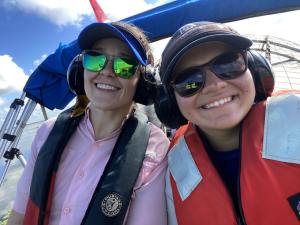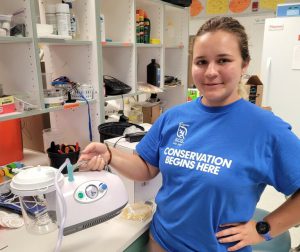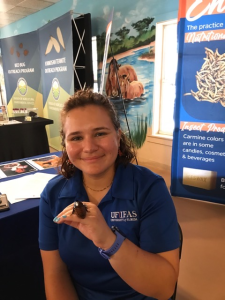FORT PIERCE, Fla.—Eloise Lamie interned at a sophisticated entomology laboratory, participated in research at the forefront of global invasion science, and found something unexpected — her people.
“Learning about environmental science is a broad topic that addresses current scientific issues across many landscapes,” said Lamie. “I have a strong interest in marine science, and I want to explore life science as it pertains to oceans—everything is interconnected—what happens in terrestrial systems affects marine systems.”

Pursuit of a career focus on sustainability and conservation
At 23, Lamie is taking new paths in the pursuit of her goals. A native of South Carolina, she recently completed a bachelor’s degree in environmental science at the University of South Carolina and chose to pursue an internship in scientific research that focused on sustainability and conservation.
Student Conservation Association links students to internship
In her search for an internship opportunity, Lamie discovered the Student Conservation Association (SCA), a nonprofit organization that places youth and adults in hands-on, conservation related internships and programs. According to the association’s website, their aim is to foster leaders who are committed to the stewardship and conservation of natural resources.
That search led Lamie to Carey Minteer, an internationally acclaimed assistant professor at the University of Florida who fights Florida’s invasive plants using their insect natural enemies. The invasive plants do not belong here and cost millions to manage statewide.

Minteer Laboratory at the UF/IFAS Norman C. Hayslip Biological Control Research and Containment Laboratory
Minteer leads biological control research at the UF/IFAS Norman C. Hayslip Biological Control Research and Containment Laboratory, part of the UF/IFAS Indian River Research and Education Center in Fort Pierce, Florida. The two research facilities work to protect Florida’s rich natural resources, a major goal for the University of Florida.
“Eloise’s enthusiasm about science and nature is palpable. I knew immediately that she would be an amazing addition to my lab, and I was right,” said Minteer.
Sustainable control options for widespread invasive species
According to Minteer, her laboratory focuses on developing sustainable control options for widespread invasive plants, including Brazilian peppertree, earleaf acacia, water hyacinth, and air potato. Some of these invasives, like air potato and tropical soda apple, can be controlled by insects that feed on the invasive species to reduce their populations, with little human intervention. The lab-tested insects save park managers, ranchers, and homeowners money and time that is otherwise spent on controlling these invasives by removal with heavy machinery or chemical pesticides to stop their growth.
“The work we do at the UF/IFAS biocontrol lab is amazing and positive,” said Lamie. “Working with the people here has deepened my respect for the hard work that goes into research. Huge environmental issues can seem impossible to engage with, but every scientist I have worked with is committed to contributing to the solutions.”
Immersion in biological control and marine science
Immersion in a biological control laboratory with global impact and influence in invasion science revealed other opportunities for Lamie during her studies. She volunteered her time assisting in marine science investigations at Florida Atlantic University’s Harbor Branch Oceanographic Institute, also in Fort Pierce. There, she studied marine sponges and learned new lab skills.
“As oceanic conditions change with the onset of climate change, familiar sights such as coral reefs will be changed forever. The ocean environment has always been subject to changes, but human influence has intensified these natural fluctuations in a way that leaves slowly adapting species without a path to survival.”
Study abroad in Ecuador
Lamie made similar observations during a study-abroad program in Ecuador, where her work in the South American nation’s diverse biological environments took her to the Amazon jungle and the Galapagos Islands.
“I was lucky enough to dive at one site multiple times while I was in the Galapagos, and each time I was fascinated by the complexity of the multicolored organisms growing on the rock wall. It was amazing to see the composition of creatures changing as we went deeper, something that I knew from textbooks but left a real impression on me seeing it with my own eyes.”

Biological control and invasive species
At the UF biological control lab in Fort Pierce, Lamie observed real life ecology in Minteer’s research program. In the field, Lamie’s co-workers showed her characteristics of invasive pests and how they alter natural landscapes and crowd out native vegetation. But she learned that biological control agents approved by state and federal agencies that are released onto infestations of invasive species could help restore natural areas. These biocontrol agents must first undergo a gauntlet of tests in the lab’s high-security quarantine lab, a process she became a part of.
“Eloise has a very keen sense of observation, and she enjoys watching the organisms with which she works,” said Minteer. “Her attention to detail allows her to make unique discoveries that most people would miss. This talent will serve her well as she navigates her path towards working in marine biology.”
Academia
Research at the biocontrol lab was enlightening, as was her glimpse into academia. Lamie observed that scientists conduct preliminary research in the field, greenhouses, and laboratories, develop proposals, and then conduct full experiments. She reviewed written documents and understood how scientific studies are accepted for publication in leading science journals.

Educational outreach
On a local level, Lamie said the Minteer lab team members organize and provide educational outreach programs to teach the public, local science teachers, and their students about invasion science.

“We interacted with people of all ages, from schoolchildren in collaboration with their teachers to cattle ranchers at a livestock exposition,” Lamie said. “Biocontrol and science are beneficial to everyone, and the best way to see a change in our community is by reaching out and communicating with them.”
Onto marine science
Lamie is about to conclude her year working to help control invasive plant species in Florida. She will leave the invasive plant research to us while she further pursues her goal of working in marine science, Minteer said.
“I am grateful for the opportunities I had at the Minteer lab,” said Lamie. “I learned that I enjoy being around scientists. Being with like-minded people who conduct research to protect our natural resources increased my own interest in research. Wherever my next step leads, I know that I always want to work with people who mirror my passion.”
 6
6
